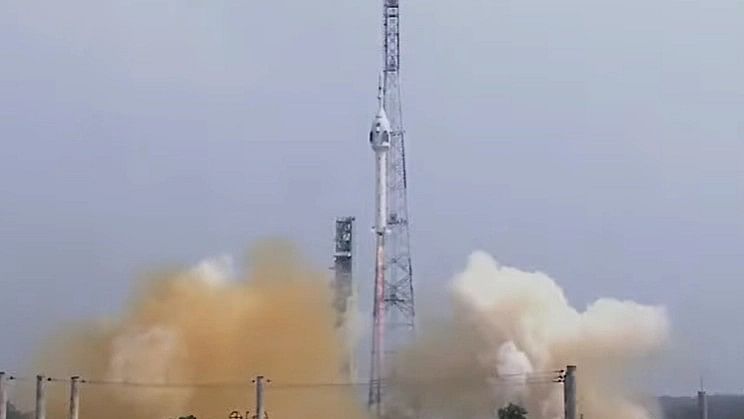
Launch of maiden test vehicle for the Gaganyaan human space flight mission.
Credit: X/@PTI
Chennai: After an initial hiccup, India’s first manned mission to the space, Gaganyaan, began on a positive note on Saturday with the successful launch of the first flight test from the Satish Dhawan Space Centre (SDSC) in Sriharikota, 110 km from here.
The Test Vehicle Abort Mission (TV-D1) took off successfully at 10 am and separated the Crew Escape System (CES) and the Crew Module (CM) from the test vehicle at an altitude of 17 km. Subsequently, the abort sequences were executed and the CES was separated with the deployment of parachutes, finally culminating splashing down gently in the Bay of Bengal, 10 kms from the coast of Sriharikota, exactly 11 minutes later.
In the evening, the Indian Navy said its units recovered the Crew Module - a path paved by extensive planning, training of Naval divers, formulation of SOPs and joint communication by combined teams of Indian Navy and ISRO.
Gaganyaan mission, which is expected in late 2024 or early 2025, envisages a demonstration of human spaceflight capability by launching a human crew of three to an orbit of 400 km and bringing them back. Four Indian Air Force pilots have been selected as the first batch of astronauts, whose identities have not been revealed.
The successful lift-off preceded some nail biting moments as the Indian Space Research Organisation (ISRO) initially postponed the launch from 8 am to 8.45 am due to bad weather and "calling off" the abort mission just a few seconds before the launch after the Automatic Launch Sequence held back the launch vehicle due to observance of an "anomaly".
However, the scientists successfully rectified the error immediately and executed the launch, putting on track the country’s first human spaceflight mission, which will cost Rs 9,000 crore.
“Happy to announce the successful accomplishment of the TV-D1 mission,” ISRO Chairman S Somanath announced, leading to loud cheers among scientists at the Mission Control Centre.
"The purpose of this mission was to demonstrate the crew escape system for Gaganyaan program through a test vehicle demonstration in which the vehicle went up to a Mach number, which is slightly above the speed of sound, and initiated an abort condition for the crew escape system to function,” he said.
The abort mission used a single-stage liquid rocket with the payloads consisting of the CM and CES (CES) with their fast-acting solid motors, along with CM fairing (CMF) and Interface Adapters.
“Till now, based on the data, everything has performed very nominally and perfectly,” he said, and explained why the mission was put on hold.
Somanath said the Automatic Launch Sequence (ALS) detected sort of a non-conformance for allowing the engine to continue the thrusting. “This happened due to a monitoring anomaly in the system. We could identify it very fast and correct it. I am very happy that our team could understand how to come back as fast as possible after detecting an anomaly. Congratulations to all,” he added.
The TV-D1 mission is aimed at demonstration of the flight, evaluation of test vehicle sub systems, evaluation of crew escape systems including various separation systems, deceleration systems demonstration at higher altitude and its recovery.
Hyderabad-based Ananth Technologies Pvt. Ltd said it played a pivotal role in the Gaganyaan TV-D1 by supplying several mission critical systems.
“This collaboration marks a major achievement for us, as we bring our technical expertise and manufacturing capabilities to assist India's space exploration initiatives," Dr Subba Rao Pavuluri, CMD, ATL. said.